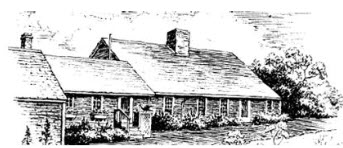The Eleanor M. Williams

According to records available at the Maine Maritime Museum:
- The ship was built in Machias, Maine, in 1890, with the home port as New York City
- Daniel E. Corbett was part owner and commander in 1890
- Her official number was 136159 and signal letters were KHRC
- Captain Daniel Corbett was also part owner and commander of the bark Harriet Stevens and was master of the brig C.H. Kennedy built in Lubec in 1853.
Eleanor M. Williams
Built in 1890
Captain Daniel E. Corbett
The Eleanor M. Williams was built by John Shaw, the master builder of Machias, Maine. There were a number of shareholders in this vessel, some of whom were: John Shaw, Charles Inglee, H. E. Saunders, Daniel E. Corbett, Annie T. Corbett, Mary A. Thompson, G. Harris Foster, William C. Holway, Charles J. McLaughlin of Machias, Charles H. Welch, Zemro H. Thompson of Machiasport, Hattie P. Wilder of Cutler, Henry P. Dewey of Portland, James E. Brett, Belcher T. Thurlow, Hattie P.Thurlow, Tristram T. Corbett, David J. Taft, John T Langhill, Alexander O. Williams, Willardson and Johnson, Sarah Burgess and Oliver O. Terrell of New York City.
Designed and built with a billet head and rounded stern, this barkentine was used principally for the transportation of lumber; she was given a thirteen-year rating, and was still in service in 1902. The signal letters were K.H.R.C.
The Eleanor M. Williams was an ill-fated ship. Originally built for the Brazil coffee trade, during her first voyage where she laid in a Brazilian port for almost nine months waiting for a return shipment of coffee. The demurrage charges came to one-half her value and on her return she had to be replanked. In those days Mr. Shaw did not copper his ships until they had earned enough money for the coppering job.
On a subsequent trip the stern was ripped off in a collision with a steamer, and later a heavy storm dismasted her [see below].
From 1847 to 1890 John Shaw built a total of 56 vessels, representing a complete estimate of 14,575 tons. In 1890, he built the two mastered schooner, Regina, his last creation, which was eventually purchased by Booth Tarkington and became a long familiar site at her mooring in the Kennebunk River at Kennebunk, Maine, where Mr. Tarkenton used her as a studio workshop.
Eleanor M. Williams was 159 feet long, 32 feet breadth, 18 feet depth of hold; 718 gross tons, 681 net tons.
Source: Short, Vincent, and Edwin Sears. Sail and Steam Along the Maine Coast. Portland, ME: The Bond Wheelwright Co. 1955.
“The North German Lloyd steamship Stuttgart arrived yesterday morning with the American barkentine Eleanor M. Williams in tow. The barkentine was in a damaged condition.
When the Stuttgart was running along at half speed at 1:40 o’clock A.M. Aug. 13 the bell of a vessel was heard ringing rapidly, according to Capt. Kohlenbeck of the Stuttgart. Before anything could be done to avert a collision, the Stuttgart crashed into the Eleanor M. Williams, which was under full sail, cut off the overhang of her stern, and carried away her wheel. The Stuttgart was stopped, and the stricken vessel was hailed. In reply to inquiries it was said that the vessel, to be saved, must be taken in tow. The collision occurred in the latitude 40 degrees 46 minutes, longitude 69 degrees 23 minutes, about twenty-five miles east of Davis South Shoal Lightship. The steamer started ahead at 4:00 o’clock A.M. with the bark and time in tow for New York.
Capt. Corbett of the Williams made his statement with evident reluctance. He said he did not blow his horn or ring the bell, considering that the fog was not thick enough to call for the employment of either signal.
Capt. Kohlenbeck asserts that there was a dense fog at the time of the collision, and that he had taken every precaution to guard against collision. In addition to the two deck lookouts, he had stationed a seamen aloft, and was himself keeping vigil on the bridge, with two officers.
The tiller of the Williams was not damaged, although the wheel was swept away. Tackles were attached to the tiller, and canvas was hung over the stern to keep the water from crashing through the breach in the stern. The vessel was leaking slightly, but, as long as the head was kept on the vessel, this could be easily freed.
The Eleanor M. Williams is a barkentine 682 tons. She was built at Machias, Maine, in 1890, and is owned in New York. Her agents are James E. Brett & Co. She was bound for Cuba to Boston with a cargo of molasses.”
Source: “The Eleanor M. Williams Towed to Port in a Damaged Condition – Contradictions as to the Weather.” The New York Times 15 Aug. 1895.
“The recent voyage of the bark Eleanor M. Williams, Captain T.T. Corbett, furnishes an illustration of a dedicated captain. This vessel sailed from Philadelphia for Ponce and Mayaquez. When within 600 miles of Ponce the foremast was lost. Capt. Corbett however, kept his course and arrived at Ponce, discharged his cargo there and had his vessel towed to Mayaquez where the remainder of the cargo was discharged. While at the latter port he took down the mizzentopmast, rigged it as a foremast and started on his return for New York where he arrived 15 days later.
Capt. Corbett is the son of Capt. Daniel Corbett of Cutler, Maine. The mother was a sister of Capt. Mark Thurlow of the same town.”
Source: New York Maritime Register 4 July 1895.
Corbett
Stories and memoires
- Tristram Thurlow Corbett: The legacy of a sea captain
- Jeanette Thurlow Corbett
- Saga Of The “Olive Thurlow”
- Olive Corbett Duncan: Memoire
- Willeby T. Corbett: Memoire
The Ships

0 Comments